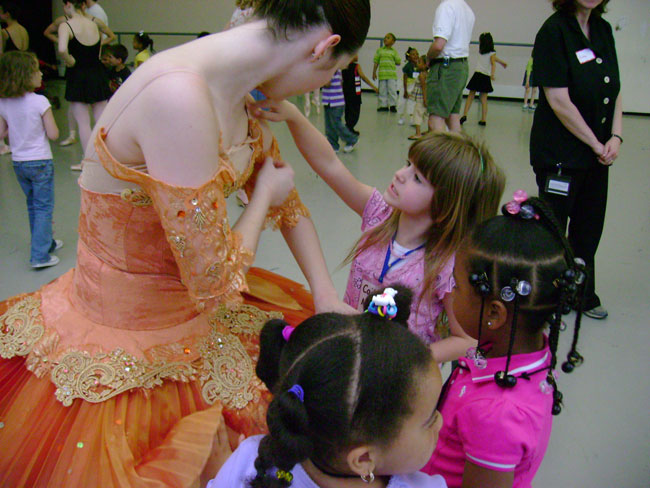PBT Education
Pittsburgh Ballet Theatre Pilots Audio Description Program at Dec. 14, Performance of The Nutcracker
Following the introduction of braille and large-print programs this season, Pittsburgh Ballet Theatre is piloting a new Audio Description Program at the 7 p.m. Dec. 14, performance of The Nutcracker to help patrons with vision impairments visualize the choreography, set design and costumes set to Tchaikovsky’s iconic score.
Beyond listening to live verbal descriptions during the production, patrons can get a full sensory experience by attending a pre-performance “Touch Tour” at 5:45 p.m. on Dec. 14, in the Benedum Center’s South Lounge. Assisted by a costumed dancer, attendees will have the opportunity to touch costume samples, such as the Sugarplum Fairy tutu’s stiff netting and intricate embellishment, a textured tactile map of the stage set layout and the poses of signature choreography, such as the carriage of the hands in the Snow Scene. Following the performance, PBT Education Director Alyssa Herzog Melby, who will audio describe the production, will host a feedback session with attendees to evaluate PBT’s first audio-described production.
“Although Pittsburgh already offers well-established audio description programs for opera and theatre, we believe this will be the first program in the Pittsburgh arts community that is specifically tailored to dance,” Melby said. “The thing about describing for dance which makes it so challenging–and rewarding–is that the describer can’t rely on dialogue or lyrics to help tell the story. The describer becomes a storyteller, painting a vivid mental picture for patrons of all the movement intricacies that are happening onstage.”
In preparation for the pilot program, Pittsburgh Ballet Theatre and the Pittsburgh Cultural Trust co-hosted an Audio Description for Dance training workshop at the PBT Studios led by expert dance describer Ermyn King of the Washington, D.C. area.
The training – which included representatives from the Cultural Trust, Pittsburgh Opera and City Theatre — was designed for describers with previous audio description training and experience. Using live dance demonstrations, the course covered best practices and dance description fundamentals, including Laban Movement Analysis, which uses concepts such as body, energy, space and time to characterize choreography. Many of the describers in attendance volunteer for other Pittsburgh arts organizations and now have the skills necessary to describe for Pittsburgh Ballet Theatre productions and other dance events in the city.
The audio description will stream live through the Benedum Center’s assistive listening devices, which ushers are trained to offer and explain to patrons. The headsets for the audio-described performance are available on a first-come, first-served basis at a kiosk in the Benedum Center lower lobby in the right hallway. Upon arrival, patrons should see an usher for more assistance. Patrons will be asked for an ID in order to borrow a headset.
For tickets or more information about The Nutcracker, click here.
Schools Get “In Step” with PBT

PBT dancer Corey Bourbonniere thinks he would have converted from tap to ballet training long before age 14 if he’d experienced a program like PBT’s “In Step” education series as a child.
While enrolled in the PBT School Graduate Program, Corey served as a dancer demonstrator for the program, which introduces students of all ages to the art of ballet through a series of performance-based instructional programs.
“You’re able to learn what your interests are when you’re exposed to things at such a young age,” he said. “I just think it’s great for kids to learn dancing at such an early age, just like they learn art and music.”
With PBT’s 2012-2013 Season premiering in October, the start of a new school year also kicks off a new season of opportunities for PBT and local schools and educators to bring classroom curriculum “In Step” with PBT.
Although each level of the series incorporates a costumed dancer, on-your-feet instruction and ballet basics, the programs can be adapted to a range of ages, classroom needs and curriculum connections.
While participating in an “In Step” program at Stanwood Elementary, for example, Corey demonstrated barre and centre work to a classroom of students and worked with small groups to combine ballet movements in a creative exercise.
“It was really fun to be able to work with them. You could just see their faces lighting up to be working with dancers,” Corey said. “Just like any other art form, you have to share it. The kids are the next generation. It keeps the art going and it keeps it alive.”
For educators, the “In Step” program taps into students’ energy and curiosity to blend learning about pointe shoes, choreography and training with on-your-feet activities. From ballet-related stories to creative movement and basic ballet positions, the “In Step” series offers programs for Pre-K through Grade 12.
“Students were attentive, because the information and dancing were in perfect balance with each other. Observing the various poses and movement that were demonstrated by the dancers helped students to be more confident when it was their turn to try the movements. This program was informative, interactive, and most importantly, fun!” said Kathy Vollrath of Hempfield Area School District.
The “In Step” series includes Ballet FUNdamentals (PreK-2), In Step (Grades 3-12), Preschool Discover Dance (Ages 3-5) and Discover Dance (all ages), a partnership with Gateway to the Arts. For more information, or to reserve a program for your classroom, contact PBT Director of Education and Community Engagement Kathryn Gigler at kgigler@pittsburghballet.org.
